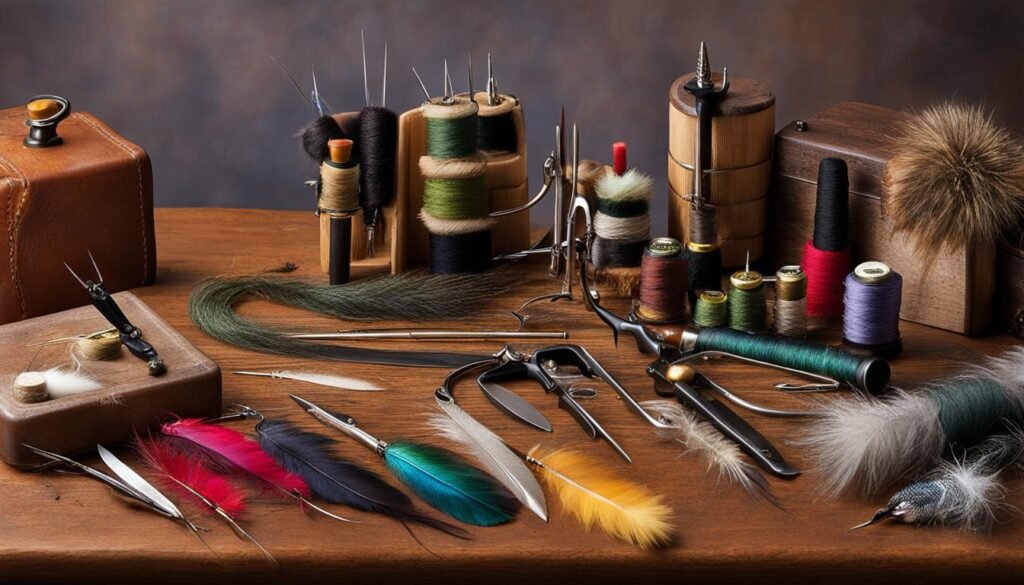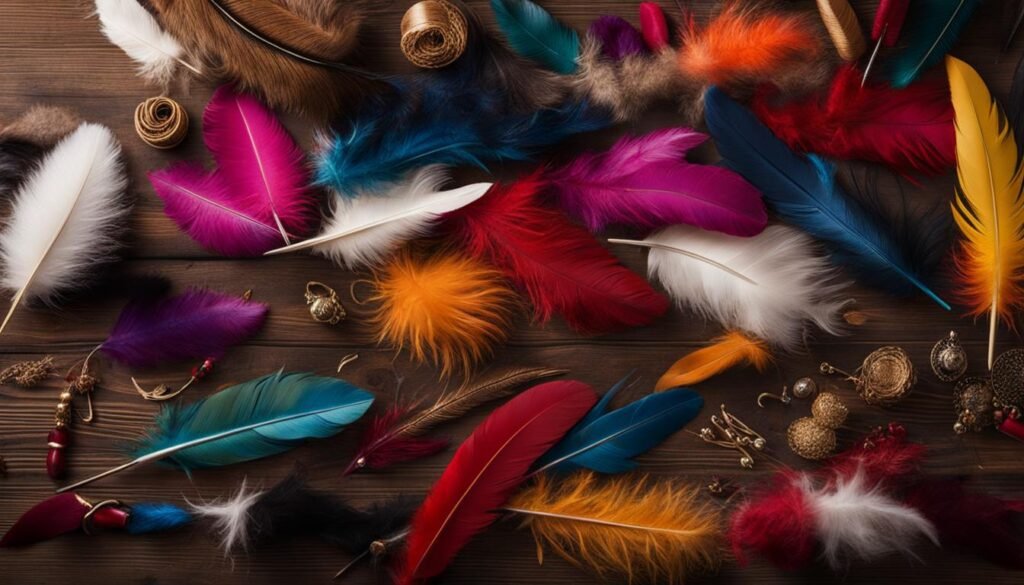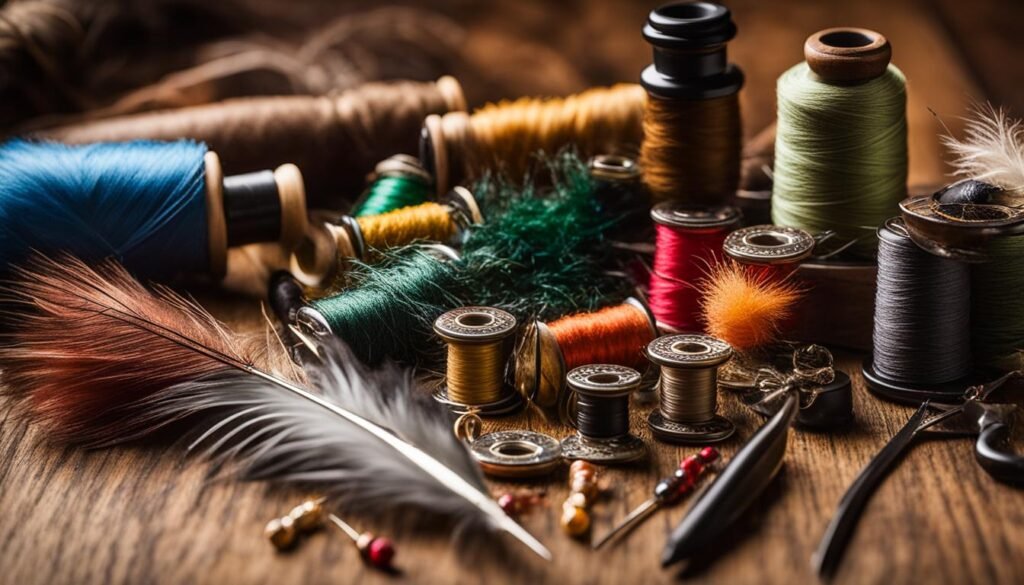Fly tying is a captivating skill that allows you to create artificial imitations of insects and other creatures for fly fishing adventures. With the right materials, tools, and techniques, you can become a master at fly tying and take my fly fishing to new heights.
By customizing fly patterns to suit my fishing needs, I can potentially increase my catch rate and gain a competitive edge on the water. Tying your own flies is not only rewarding and satisfying but also helps develop a deeper understanding of entomology and improve your overall fishing skills.
The Benefits of Fly Tying
Fly tying is not just a hobby; it offers a range of benefits that can enhance your fly fishing experience. By creating your own fly patterns, you can customize them to suit your fishing needs and potentially increase your catch rate. Imagine presenting a fly on the water that perfectly mimics the insects or baitfish that fish are actively feeding on. This level of customization gives you a competitive edge and can lead to more successful fishing trips.
Moreover, tying your own flies can be a rewarding and satisfying experience. When you catch a fish using a fly that you have crafted with your own hands, the sense of accomplishment is unmatched. It allows you to connect with the sport on a deeper level and brings a sense of pride and fulfillment. Not to mention, tying flies provides an opportunity to tap into your creativity and experiment with different materials, colors, and techniques.
Learning fly tying patterns and instructions can also help you develop a deeper understanding of entomology and improve your overall fishing skills. As you familiarize yourself with the types of insects that fish feed on, you’ll be able to design flies that imitate their appearance and behavior. This knowledge will enable you to make informed decisions about which flies to use in different fishing situations, increasing your chances of success on the water.
Benefits of Fly Tying
| Benefits | Explanation |
|---|---|
| Customization | Create flies tailored to your fishing needs and imitate specific insects or baitfish. |
| Rewarding Experience | Catch fish with flies you’ve created yourself, and feel a sense of accomplishment. |
| Creativity | Experiment with different materials, colors, and techniques to design unique fly patterns. |
| Knowledge and Skill Development | Learn about entomology and improve your understanding of fish behavior and feeding habits. |
As you can see, fly tying offers numerous benefits that can take your fly fishing to the next level. It allows you to customize flies, provides a rewarding experience, nurtures your creativity, and deepens your knowledge of the natural world. So, why not give fly tying a try and unlock a whole new dimension of fishing enjoyment?
The Essential Fly Tying Materials and Tools

Fly tying is a creative and intricate process that requires a variety of materials and tools to bring your fly patterns to life. By investing in the right materials and tools, you can ensure that your flies are durable, realistic, and effective in attracting fish. Here are some of the essential fly tying materials and tools that every fly tier should have in their arsenal:
Fly Tying Materials
1. Thread: High-quality thread is essential for securing materials and creating a strong foundation for your flies. It comes in various colors and thicknesses to match the size and color of the fly you’re tying.
2. Feathers: Feathers are used to create wings, tails, and body components of the fly. They come in a wide range of colors and patterns, allowing you to mimic the natural appearance of insects.
3. Dubbing: Dubbing is a blend of natural or synthetic materials that is used to create the body of the fly. It adds texture and volume, making your flies more realistic and lifelike.
4. Tinsel, Floss, and Wire: These materials add flash and durability to your flies. They can be used to create ribbing, bodies, and segmented sections, giving your flies a more enticing appearance in the water.
Fly Tying Tools
1. Vise: A fly tying vise is used to hold the hook securely while you tie your flies. It should have a strong grip and adjustable jaws to accommodate different hook sizes.
2. Scissors: A good pair of fly tying scissors is essential for cutting various materials, such as thread, feathers, and tinsel. They should be sharp and have fine tips for precise cutting.
3. Bobbin Holder: A bobbin holder is used to hold the thread and control tension while tying your flies. It allows for smooth thread application and prevents tangling.
4. Dubbing Needle: A dubbing needle is used for various purposes, such as applying adhesive, picking out dubbing, or creating small holes in materials. It is a versatile tool that comes in handy during the fly tying process.
By having a well-stocked inventory of fly tying materials and tools, you can create beautiful and effective flies that will entice fish and enhance your fishing experience.
Fly Tying Techniques for Success
When it comes to fly tying, mastering different techniques is key to creating effective and realistic flies. With the right skills, you can craft flies that imitate insects and baitfish with precision, increasing your chances of a successful fishing outing. Here are some essential fly tying techniques to help you improve your tying game:
Wrapping:
The wrapping technique involves securing materials, such as feathers or tinsel, around the hook shank to create the body of the fly. It’s important to maintain even tension while wrapping to ensure a neat and uniform appearance. Practice controlling the tension and spacing of your wraps to achieve the desired shape and profile for your fly.
Dubbing:
Dubbing is the process of applying a blend of natural or synthetic fibers to the thread and then wrapping it around the hook to create a body or other parts of the fly. This technique allows you to add texture, color, and bulk to your flies, making them more attractive to fish. Experiment with different types of dubbing materials to achieve the desired effect.
Hackling:
Hackling involves attaching feathers or other materials to the hook in order to create lifelike legs or wings on the fly. This technique adds movement and realism to your patterns, making them irresistible to fish. It’s important to select the appropriate feather and understand the proper methods for attaching and wrapping it to achieve the desired effect.
While these are just a few examples of fly tying techniques, there are many more to explore and master. One of the best ways to learn these techniques is by watching fly tying videos. These visual demonstrations provide step-by-step instructions and helpful tips from experienced fly tiers. By combining different techniques and materials, you can create flies that accurately imitate the insects and baitfish found in your local fishing waters, increasing your chances of a successful fishing experience.
| Technique | Description |
|---|---|
| Wrapping | Securing materials around the hook shank to create the fly’s body. |
| Dubbing | Applying a blend of fibers to the thread and wrapping it around the hook to add texture and bulk. |
| Hackling | Attaching feathers or other materials to create lifelike legs or wings on the fly. |
Creating Your Own Fly Tying Patterns
One of the joys of fly tying is the ability to create your own patterns. By combining different materials and techniques, you can design flies that are tailored to your local fishing conditions and target species. Developing your own patterns allows you to be innovative and potentially discover new patterns that fish find irresistible. The key to creating successful fly tying patterns is to understand the behavior of the fish you are targeting and the insects they feed on.
Fly Tying Patterns: A Creative Outlet
When it comes to creating your own fly tying patterns, you are limited only by your imagination. By studying the insects found in the waters you fish, you can gain insight into the patterns that will attract fish. Is there a particular insect that is abundant and attracts the attention of fish? By replicating the appearance and movement of that insect, you can increase your chances of a successful catch.
Experimentation is key when developing your own fly tying patterns. Don’t be afraid to try new combinations of materials or unconventional techniques. Sometimes, the most effective patterns are the ones that break the mold and offer something different. Keep track of your experiments and record the patterns that yield the best results. Over time, you will develop a collection of go-to patterns that consistently produce bites.
Mastering Fly Tying Instructions
Learning fly tying patterns and instructions is essential for creating your own unique flies. There are numerous resources available, including books, websites, and online videos, that provide step-by-step instructions and tutorials. These resources will help you grasp the fundamental techniques and principles of fly tying, allowing you to build a strong foundation for your pattern creation.
As you gain experience and confidence, you can begin to modify existing patterns or combine elements from different patterns to create your own signature flies. This level of creativity and personalization is what sets experienced fly tiers apart from the rest. Don’t be afraid to take risks and let your imagination run wild. Who knows, you may just discover the next game-changing fly pattern that revolutionizes the fly fishing world.
| Fly Tying Patterns Tips | Fly Tying Instructions Resources |
|---|---|
|
|
Recommended Fly Tying Resources
When it comes to mastering the art of fly tying, having access to reliable resources is essential. Fortunately, there are plenty of options available to help you improve your skills and expand your knowledge. Whether you prefer books, websites, or videos, these resources can provide you with the guidance and inspiration you need to take your fly tying to the next level.
Fly Tying Instructions
One of the best ways to learn fly tying is through detailed instructions. Many books and websites offer step-by-step guides that cover a wide range of fly patterns and techniques. These instructions typically include information on which materials to use, how to assemble the fly, and tips for achieving the desired result. By following clear and concise instructions, you can quickly develop your skills and create beautiful and effective flies.
Fly Tying Videos
If you prefer visual demonstrations, fly tying videos are an excellent resource. There are numerous websites and YouTube channels dedicated to fly tying, where experienced fly tiers share their techniques and insights. Watching these videos allows you to see the tying process in action, making it easier to understand the steps and techniques involved. Additionally, many videos provide helpful commentary and tips that can further enhance your understanding and improve your tying skills.
By utilizing both written instructions and videos, you can benefit from a well-rounded approach to fly tying education. Take advantage of these resources to learn new patterns, master different techniques, and gain inspiration for creating your own unique flies.
Fly Tying Equipment
Alongside instructional resources, it is important to invest in quality fly tying equipment. The right tools can greatly enhance your tying experience and make the process more efficient and enjoyable. A fly tying vise is a must-have tool that securely holds the hook in place while you work. Scissors with fine, sharp blades will allow you to trim materials with precision. Other essential tools include bobbin holders, dubbing needles, and hackle pliers.
When choosing fly tying equipment, opt for reputable brands known for their durability and functionality. While it may be tempting to go for cheaper options, investing in quality tools will ensure that they last longer and perform better. Additionally, consider the specific patterns and techniques you plan to focus on when selecting your equipment. Certain flies may require specialized tools, so it’s important to have a well-rounded collection.
Exploring the Art of Fly Tying

Fly tying is a dynamic and evolving art form that allows anglers to explore new techniques, materials, and patterns. Traditional fly tying materials, such as furs and feathers, have been supplemented by modern synthetic materials, expanding the possibilities for creating unique and innovative flies.
With the advent of new materials, fly tiers can experiment with endless combinations to imitate insects and attract a wide range of fish species in both freshwater and saltwater environments. Whether it’s creating realistic mayfly imitations or designing flashy streamer patterns, the art of fly tying offers endless opportunities for creative and adventurous anglers.
By delving into the world of fly tying, you can tap into your imagination and bring your visions to life. From classic patterns to cutting-edge creations, the boundaries of what can be achieved are constantly being pushed. With each new fly, you have the chance to test your skills, refine your techniques, and discover innovative approaches to fooling fish.
Materials and Techniques
| Fly Tying Materials | Fly Tying Techniques |
|---|---|
| Feathers | Dubbing |
| Hair | Wrapping |
| Furs | Hackling |
| Synthetic materials | Finishing |
As you explore the art of fly tying, you’ll quickly discover that the possibilities are limited only by your imagination. By combining different materials and techniques, you can create flies that perfectly match the insects found in your local waters or push the boundaries of realism with imaginative and innovative patterns.
Whether you’re a novice or an experienced fly tier, the art of fly tying offers a world of creativity and self-expression. It’s a journey that can lead to a deeper connection with nature, a greater understanding of fish behavior, and a lifetime of excitement and discovery on the water.

